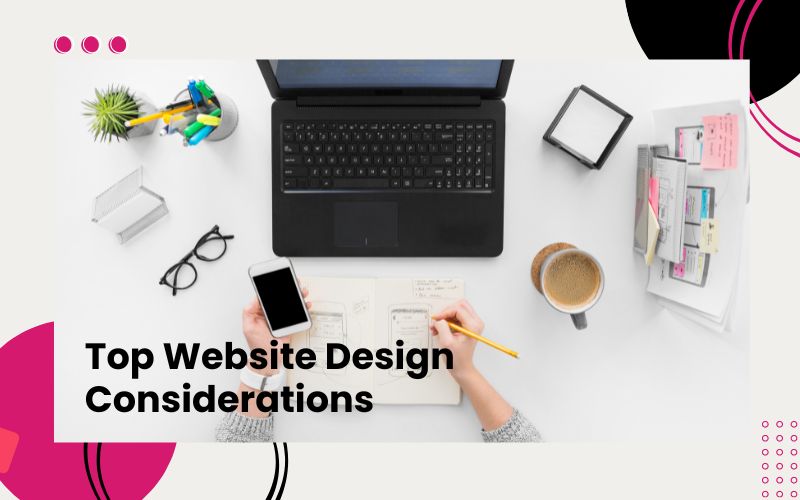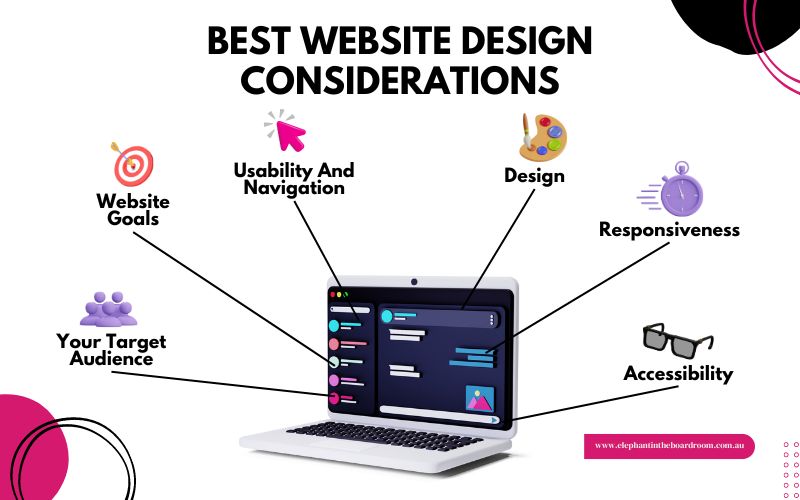
Top Website Design Considerations
Are looking to build a shiny new website or give your current one a much-needed makeover? The success of your online presence hinges on a few key website design considerations that can make all the difference.
It can be a bit tricky to know where to start. From understanding your target audience to ensuring your site is accessible to all users, it’s easy to get lost in the details. By focusing on the right considerations, you can transform your website into a powerful tool that not only looks great but also delivers results.
So, what exactly should you keep in mind as you embark on your web design journey? Let's break down these key website design considerations, and create a stunning yet functional website design that amazes and impresses!
What’s Inside?
- Why Are Website Design Considerations Important?
- Website Design Considerations
- Empower Your Website With Us!
Why Are Website Design Considerations Important?
Well, getting these elements right doesn’t just make your website look good. It also help in crafting an experience that draws visitors in and keeps them engaged. When you focus on the key website considerations before building a new website, like understanding your audience, ensuring accessibility, and optimising for mobile, you’re setting yourself up for success.
Here's a breakdown of why these website design aspects matter.
Prioritises Target Audience
If you fine-tune your website design to your target audience's preferences, you create a welcoming and relevant experience that makes them feel understood. This increases engagement and keeps them browsing for more.
Clear Navigation For Customers
A clear and intuitive navigation bar, one of the website design considerations, acts as a map for your website, guiding visitors to the information they need quickly and effortlessly. This reduces bounce rates and keeps them exploring your offerings.
Mobile First Design
In today's mobile-centric world, you're missing out on potential customers if your website isn't optimised for smartphones and tablets. A responsive design ensures a smooth user experience on any device, keeping visitors engaged and happy, regardless of where they access your website.
High Quality Content
Engaging content informs, educates, and entertains your audience, keeping them glued to your website. This builds trust and brand loyalty and can indirectly convert visitors into leads or customers.
Well-written content with relevant keywords helps search engines understand your website, so people will find you online more easily.
Clear Calls-To-Action (CTAs)
A website with fantastic design but no clear CTAs leaves visitors unsure of what to do next. Strategic CTAs, like buttons or forms, guide users toward your desired actions, whether it's subscribing to a newsletter, making a purchase, or contacting you for more information.
Website Design Considerations

Your Target Audience
Why is your target audience one of the vital website design considerations? Well, for starters, it shapes everything from the look and feel of your site to its functionality. Knowing what appeals to your audience helps you design a site that captures their attention and keeps them engaged.
Relevance and Connection
People connect with things they find familiar and relatable. Knowing your target audience's demographics, interests, and online behaviour lets you design a website that speaks directly to them.
Imagine a website for young artists. Using bright colours, playful fonts, and showcasing edgy artwork would resonate with them far more than a website with muted tones and stock photos. Also, a website that considers your target audience creates a sense of connection and makes visitors feel welcome.
Engagement and User Experience
If your website design isn't reaching your target audience well, they're likely to click away. Understanding their preferences for visuals, language, and overall tone allows you to craft an engaging and interesting user experience.
Conversions and Business Goals
Ultimately, your website is a tool to achieve your business goals. Whether it's selling products, generating leads, or promoting brand awareness, understanding your target audience is key. By designing a website that caters to their needs and desires, you're more likely to convert visitors into paying customers or loyal fans.
For instance, a website for a financial advisor targeting retirees might prioritise clear calls to action for booking consultations, while a website for a clothing store targeting young adults might focus on showcasing trendy styles and easy online shopping options.
Website Goals
Your website goals are crucial website design considerations because they act as the roadmap for your entire website. It answers why you built your website.
Focus and Clarity
Having clear website goals helps you prioritise design elements that directly contribute to achieving those goals.
For instance, if your primary goal is to generate leads, your website design might prioritise clear contact forms, prominent calls to action for subscribing to newsletters, and informative content that establishes your expertise.
Conversion Focused User Experience (UX)
Understanding your website goals allows you to tailor the user experience (UX) to encourage specific actions. This could involve designing clear buying journeys for e-commerce sites, strategically placing CTAs near relevant content, or simplifying contact forms to remove friction for lead generation.
Content Strategy and Design Cohesion
Your website goals influence the type of content you create and how it's presented. For example, a website to build brand awareness might prioritise blog posts, infographics, and engaging videos.
Usability And Navigation
Usability and navigation are crucial website design considerations for a few key reasons as a web designer.
Reduced Bounce Rates
Clear navigation and a user-friendly design ensure visitors can find the information they need quickly and easily, keeping them engaged and happy. It results in lower bounce rates and a more positive overall experience.
Improved SEO
Search engines like Google consider how easy a website is to navigate when ranking it in search results. Clear navigation with well-labelled pages and a logical structure helps search engines understand your website's content and improves its ranking for relevant keywords. This organic visibility can significantly increase website traffic.
Design
Design is your website's lifeline and cradle of identity, that's why it's also a crucial website design consideration. This makes your business memorable to your customers.
First Impressions Matter
In the digital age, attention spans are short. Visual design is what grabs a visitor's attention in those crucial first seconds. A visually appealing best homepage design with high-quality images, a clean layout, and a cohesive colour scheme creates a positive first impression and entices visitors to stay and explore further.
Establishes Brand Identity
75% of customers believe website design shapes business credibility. Your website's visual design is a powerful tool for communicating your brand identity. The colours, fonts, and overall style you choose should all reflect your brand's personality and values.
Emotional Connection
Visuals can evoke emotions and influence how users feel while navigating your website. Using calming colours and soothing visuals on a meditation app creates a sense of tranquility, while high-energy visuals and bold colours on a fitness website can motivate users and turn them into the best homepage design.
Information Hierarchy and Clarity
Visual design also guides your website visitors. Using contrasting colours, varying font sizes, and strategic placement of images can create a visual hierarchy helping users focus on important information and complete desired actions.
Responsiveness
Responsive web design is a crucial website design consideration in today's digital landscape. This determines if your website is worth visiting from its potential users.
Mobile-First World
The way we access the internet has drastically changed. These days, a significant portion of website traffic comes from smartphones and tablets. If your website is mobile-responsive, meaning it adjusts its layout to fit any device's screen size, it will be great for navigation with mobile users.
SEO Boost
Search engines like Google prioritise mobile-friendly websites in search results. A responsive website design ensures your website displays correctly on all devices, sending positive signals to search engines and potentially improving your website's ranking for relevant keywords.
Enhanced User Experience (UX) Across Devices
A responsive website ensures that menus are easy to tap on touchscreens, text is readable without zooming, and calls to action are clear and clickable. This consistency across devices keeps your users engaged and happy, regardless of how they choose to access your website.
Cost Effective Maintenance
In the past, businesses might have needed separate websites for desktop and mobile users. Responsive design eliminates this need, saving you development and maintenance costs. You can manage and update a single website that provides an optimal experience for visitors on any device.
Accessibility
Accessibility in website design is crucial for several reasons, and it goes beyond just being the 'right thing to do.' Here's why accessibility is an important website design consideration.
Wider Audience Reach
An accessible website opens your doors to a much broader audience. People with disabilities, including those with visual impairments, hearing difficulties, or motor limitations, can navigate and interact with your website effectively.
Legal Compliance
In many countries like Australia, there are legal regulations regarding website accessibility as it is one of the important website design aspects. By adhering to accessibility standards, you can avoid potential legal issues and ensure you're not discriminating against any user group.
Improved Brand Reputation
In today's digital world, social responsibility is a key factor for consumers. By prioritising accessibility, you demonstrate your commitment to inclusivity and cater to a diverse range of users. This can enhance your brand reputation and build trust with a wider audience.
Future-Proofing Your Website
As technology evolves, assistive technologies like screen readers are becoming more prevalent. An accessible website design ensures your website remains usable for everyone, regardless of future advancements or potential limitations a user might have.
Empower Your Website With Us!
So, there you have it! Website design might seem complex, but you can create a user-friendly and stunning website with all these website design considerations in mind.
Ready to create a website that wows? We're here to help! We're a bunch of web design and development wizards who can translate your vision into a beautiful and functional website.
Head over to our website and get started with the charismatic web design services for your business! We'll walk you through the entire process, from brainstorming ideas to launch day, and ensure your website becomes a powerful tool for attracting new customers and growing your business.
Don't wait – take the first step towards a website that works as hard as you do!



